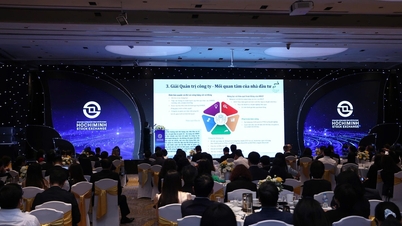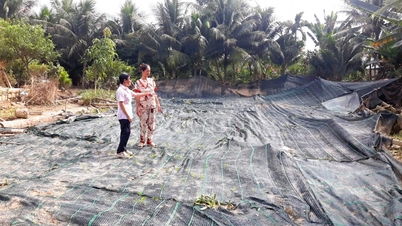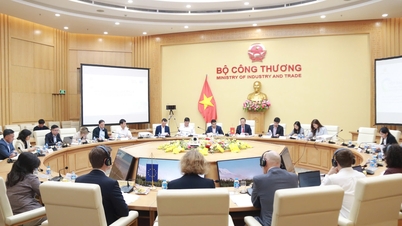On the morning of April 17, the National Economics University coordinated with the Central Economic Committee and the Economic Committee of the National Assembly to organize a National Scientific Conference to assess Vietnam's economy in 2023 and prospects for 2024. At the same time, the University announced the 2023 Annual Vietnam Economic Assessment Publication of the University. The theme of the Conference as well as this year's annual publication is "Vietnam's economy in 2023 and prospects for 2024: Promoting aggregate demand for economic growth in the new context".
Aggregate demand plays an important role.
According to the Report's assessment, in 2023, the world economic context is still full of risks and instability, and Vietnam's economy is also heavily impacted. Gross domestic product (GDP) in 2023 increased by 5.05% compared to 2022, only higher than the growth rate of 2.87% and 2.56% in 2020 and 2021 in the period 2011-2023. In 2023, the industrial and construction sector has not shown positive signs of recovery, increasing by only 3.74% compared to the previous year (low compared to the average growth rate of 8.6% in 2015-2019). In addition, the real estate market has experienced many difficulties and challenges. Total transaction volume in the four quarters of 2023 reached about 18,600 products from projects in the primary market, only 17% compared to 2018, the time before the Covid-19 pandemic.
 |
| Recovery of aggregate demand will be the fulcrum for economic growth in 2024. Photo: ST |
Total social investment capital in 2023 at current prices increased by only 6.2% compared to the previous year (in 2022, it increased by 11.2%). Similarly, foreign direct investment (FDI) in Vietnam in 2023 increased by only 5.4% (in 2022, it increased by 13.9%). Spending motivation also tends to decline. In general, in 2023, total retail sales of goods and consumer service revenue increased by only 9.6% compared to the previous year (in 2022, it increased by 20%). Export and import turnover both decreased sharply compared to the previous year, down 4.4% and 8.9%, respectively, due to lower demand from Vietnam's main markets such as the US, ASEAN, the European Union (EU) and some East Asian countries. The above figures show a sharp decline in aggregate demand in the Vietnamese economy as all three components, investment, export and consumption, have weakened.
In his opening speech at the workshop, Prof. Dr. Pham Hong Chuong, President of the National Economics University, said that recovering aggregate demand is an important task for Vietnam in 2024. This requires the Government and relevant Ministries, Departments and Branches to urgently take appropriate measures.
 |
| Overview of the Workshop |
“Aggregate demand plays an important role in determining the level of economic activity and employment in the economy. A decrease in aggregate demand indicates that the economy is at risk of recession, which affects the overall growth of the economy, causing consequences such as a decline in industrial production, high unemployment, and a decrease in people's income and spending…”, Mr. Chuong said.
Presenting the report, Prof. Dr. To Trung Thanh, Head of the Department of Science Management, National Economics University, said that in 2024, there will still be many challenges both domestically and internationally. Specifically, many major economies will still be affected by tight monetary policies in 2023, global geopolitical tensions will continue to be complicated, supply chain disruptions will affect supply sources, and trade protectionism will increase, especially in major countries.
Domestically, the traditional driving force from aggregate demand is still weak. The business sector is still facing many difficulties, the financial and macroeconomic environment still contains many risks. In addition, institutional changes to create conditions for new growth drivers are still slow, growth quality is low, and the growth model has not improved.
According to this expert, the growth momentum of the economy in 2024 will mainly rely on traditional growth drivers, private investment will basically find it difficult to increase strongly due to difficulties in the business sector, so the effective disbursement of public investment capital plays a key role. Private sector final consumption will play an increasingly important role and the foreign economy will continue to be the main pillar for growth.
Fiscal policy is the focus of supporting people and businesses.
Based on the analysis and assessment of the actual situation in Vietnam as well as in the context of the world economy, the group of authors has made a number of recommendations for macroeconomic policies to promote aggregate demand. Accordingly, on the fiscal side, the Government can consider continuing to promote countercyclical fiscal policy to promote aggregate demand and achieve stable growth in the context of recession, especially when the budget is not too tight and public debt tends to decrease. It is necessary to actively and proactively use fiscal policy to stimulate growth to deal with the problems of growth decline. Specifically, the Government needs to effectively promote public investment disbursement and can consider continuing to reduce some taxes and fees to support businesses and stimulate demand.
 |
| Experts attending the discussion at the workshop |
On the monetary side, the report said that to facilitate the promotion of credit growth to achieve the target, the SBV needs to issue and amend a number of legal documents related to credit access. At the same time, the SBV needs to implement a number of policies to increase credit access, especially for the SME group, as well as reduce lending interest rates.
For example, promoting dialogue and connecting banks and businesses to enhance information, propaganda, grasp needs, promptly handle difficulties and problems; issuing specific regulations requiring credit institutions to publicly announce important information in credit granting such as: average loan interest rates, types of fees, fee calculation methods, average annual real interest rates.
Dr. Can Van Luc, Chief Economist of BIDV, Member of the National Financial and Monetary Policy Advisory Council, also proposed a number of groups of solutions to consolidate and renew existing growth drivers. For example, successfully implementing mechanisms, policies and resolutions issued by the National Assembly and the Government; promptly removing difficulties and obstacles, especially in the land, construction, real estate and corporate bond markets.
In addition, promote existing growth drivers such as accelerating public investment disbursement; stimulating private investment and domestic consumption; applying policies to support people and businesses, in which fiscal policy is the main force and monetary policy plays a coordinating role. Pay attention to promoting growth of the economic locomotives, especially Hanoi and Ho Chi Minh City... In addition, it is necessary to focus on restructuring the economy, especially state-owned enterprises, weak projects, weak credit institutions, public investment... to attract and allocate resources more effectively, improve the business system, and enhance the resilience of the economy.
Source link





![[Photo] Parade to celebrate the 50th anniversary of Laos' National Day](/_next/image?url=https%3A%2F%2Fvphoto.vietnam.vn%2Fthumb%2F1200x675%2Fvietnam%2Fresource%2FIMAGE%2F2025%2F12%2F02%2F1764691918289_ndo_br_0-jpg.webp&w=3840&q=75)



























![[Photo] Worshiping the Tuyet Son statue - a nearly 400-year-old treasure at Keo Pagoda](/_next/image?url=https%3A%2F%2Fvphoto.vietnam.vn%2Fthumb%2F1200x675%2Fvietnam%2Fresource%2FIMAGE%2F2025%2F12%2F02%2F1764679323086_ndo_br_tempimageomw0hi-4884-jpg.webp&w=3840&q=75)







































































Comment (0)